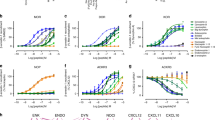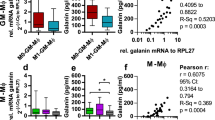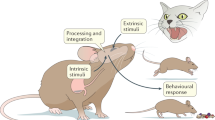Abstract
Chemokines are not only found in the immune system or expressed in inflammatory conditions: they are constitutively present in the brain in both glial cells and neurons. Recently, the possibility has been raised that they might act as neurotransmitters or neuromodulators. Although the evidence is incomplete, emerging data show that chemokines have several of the characteristics that define neurotransmitters. Moreover, their physiological actions resemble those of neuromodulators in the sense that chemokines usually have few effects by themselves in basal conditions, but modify the induced release of neurotransmitters or neuropeptides. These findings, together with the pharmacological development of agonists and antagonists that are selective for chemokine receptors and can cross the blood–brain barrier, open a new era of research in neuroscience.
This is a preview of subscription content, access via your institution
Access options
Subscribe to this journal
Receive 12 print issues and online access
$189.00 per year
only $15.75 per issue
Buy this article
- Purchase on Springer Link
- Instant access to full article PDF
Prices may be subject to local taxes which are calculated during checkout







Similar content being viewed by others
References
Besedovsky, H. O. & del Rey, A. Immune-neuro-endocrine interactions: facts and hypotheses. Endocr. Rev. 17, 64–102 (1996).
Banks, W. A. Blood-brain barrier transport of cytokines: a mechanism for neuropathology. Curr. Pharm. Des. 11, 973–984 (2005).
Greter, M. et al. Dendritic cells permit immune invasion of the CNS in an animal model of multiple sclerosis. Nature Med. 11, 328–334 (2005).
Tambur, A. R. & Roitberg, B. Immunology of the central nervous system. Neurol. Res. 27, 675–678 (2005).
Yoshimura, T. et al. Purification of a human monocyte-derived neutrophil chemotactic factor that has peptide sequence similarity to other host defense cytokines. Proc. Natl Acad. Sci. USA 84, 9233–9237 (1987).
Rossi, D. & Zlotnik, A. The biology of chemokines and their receptors. Annu. Rev. Immunol. 18, 217–242 (2000).
Berger, E. A., Murphy, P. M. & Farber, J. M. Chemokine receptors as HIV-1 coreceptors: roles in viral entry, tropism, and disease. Annu. Rev. Immunol. 17, 657–700 (1999).
Mennicken, F., Maki, R., de Souza, E. B. & Quirion, R. Chemokines and chemokine receptors in the CNS: a possible role in neuroinflammation and patterning. Trends Pharmacol. Sci. 20, 73–78 (1999).
Ubogu, E. E., Cossoy, M. B. & Ransohoff, R. M. The expression and function of chemokines involved in CNS inflammation. Trends Pharmacol. Sci. 27, 48–55 (2006).
Proudfoot, A. E., Shaw, J. P., Power, C. A. & Wells, T. N. C. in Universes in Delicate Balance: Chemokines and the Nervous System (eds Ransohoff, R. M., Suzuki, K., Proudfoot, A. E. I., Hickey W. F. & Harrison, J. K.) 65–86 (Elsevier, Amsterdam, 2002).
Bajetto, A., Bonavia, R., Barbero, S., Florio, T. & Schettini, G. Chemokines and their receptors in the central nervous system. Front. Neuroendocrinol. 22, 147–184 (2001).
Tran, P. B. & Miller, R. J. Chemokine receptors in the brain: a developing story. J. Comp. Neurol. 457, 1–6 (2003).
Banisadr, G., Rostene, W., Kitabgi, P. & Parsadaniantz, S. M. Chemokines and brain functions. Curr. Drug Targets Inflamm. Allergy 4, 387–399 (2005).
White, F. A., Bhangoo, S. K. & Miller, R. J. Chemokines: integrators of pain and inflammation. Nature Rev. Drug Discov. 4, 834–844 (2005).
Bacon, K. B. & Harrison, J. K. Chemokines and their receptors in neurobiology: perspectives in physiology and homeostasis. J. Neuroimmunol. 104, 92–97 (2000).
Miller, R. J. & Oh, S. B. in Universes in Delicate Balance: Chemokines and the Nervous System (eds Ransohoff, R. M., Suzuki, K., Proudfoot, A. E. I., Hickey W. F. & Harrison, J. K.) 273–288 (Elsevier, Amsterdam, 2002).
Harrison, J. K. in Universes in Delicate Balance: Chemokines and the Nervous System (eds Ransohoff, R. M., Suzuki, K., Proudfoot, A. E. I., Hickey W. F. & Harrison, J. K.) 237–244 (Elsevier, Amsterdam, 2002).
Mahad, D. J. & Ransohoff, R. M. The role of MCP-1 (CCL2) and CCR2 in multiple sclerosis and experimental autoimmune encephalomyelitis (EAE). Semin. Immunol. 15, 23–32 (2003).
Fife, B. T., Huffnagle, G. B., Kuziel, W. A. & Karpus, W. J. CC chemokine receptor 2 is critical for induction of experimental autoimmune encephalomyelitis. J. Exp. Med. 192, 899–905 (2000).
White, F. A. et al. Excitatory monocyte chemoattractant protein-1 signaling is up-regulated in sensory neurons after chronic compression of the dorsal root ganglion. Proc. Natl Acad. Sci. USA 102, 14092–14097 (2005).
Banisadr, G. et al. Highly regionalized neuronal expression of monocyte chemoattractant protein-1 (MCP-1/CCL2) in rat brain: evidence for its colocalization with neurotransmitters and neuropeptides. J. Comp. Neurol. 489, 275–292 (2005).
Coughlan, C. M. et al. Expression of multiple functional chemokine receptors and monocyte chemoattractant protein-1 in human neurons. Neuroscience 97, 591–600 (2000).
Meng, S. Z., Oka, A. & Takashima, S. Developmental expression of monocyte chemoattractant protein-1 in the human cerebellum and brainstem. Brain Dev. 21, 30–35 (1999).
Banisadr, G. et al. Constitutive neuronal expression of CCR2 chemokine receptor and its colocalization with neurotransmitters in normal rat brain: functional effect of MCP-1/CCL2 on calcium mobilization in primary cultured neurons. J. Comp. Neurol. 492, 178–192 (2005).
Gosselin, R. D. et al. Constitutive expression of CCR2 chemokine receptor and inhibition by MCP-1/CCL2 of GABA-induced currents in spinal cord neurones. J. Neurochem. 95, 1023–1034 (2005).
Tham, T. N. et al. Developmental pattern of expression of the alpha chemokine stromal cell-derived factor 1 in the rat central nervous system. Eur. J. Neurosci. 13, 845–856 (2001).
Banisadr, G., Skrzydelski, D., Kitabgi, P., Rostene, W. & Parsadaniantz, S. M. Highly regionalized distribution of stromal cell-derived factor-1/CXCL12 in adult rat brain: constitutive expression in cholinergic, dopaminergic and vasopressinergic neurons. Eur. J. Neurosci. 18, 1593–1606 (2003).
Stumm, R. K. et al. A dual role for the SDF-1/CXCR4 chemokine receptor system in adult brain: isoform-selective regulation of SDF-1 expression modulates CXCR4-dependent neuronal plasticity and cerebral leukocyte recruitment after focal ischemia. J. Neurosci. 22, 5865–5878 (2002).
Xia, M. Q. & Hyman, B. T. Chemokines/chemokine receptors in the central nervous system and Alzheimer's disease. J. Neurovirol. 5, 32–41 (1999).
Harrison, J. K. et al. Role for neuronally derived fractalkine in mediating interactions between neurons and CX3CR1-expressing microglia. Proc. Natl Acad. Sci. USA 95, 10896–10901 (1998).
Rotsztejn, W., Besson, J., Pattou, E. & Drouva, S. V. Hypothalamic neuropeptides (NP) can be neurotransmitters, neurohormones or neuromodulators. Adv. Physiol. Sci. 14, 217–229 (1981).
de Jong, E. K. et al. Vesicle-mediated transport and release of CCL21 in endangered neurons: a possible explanation for microglia activation remote from a primary lesion. J. Neurosci. 25, 7548–7557 (2005).
Callewaere, C. et al. Cellular and subcellular evidence for neuronal interaction between the chemokine SDF-1/CXCL12 and vasopressin: regulation in the hypothalamo-neurohypophysial system of the Brattleboro rats. Endocrinology 27 Sep 2007 (doi: 10.1210/en.2007-1097).
Callewaere, C. et al. The chemokine SDF-1/CXCL12 modulates the firing pattern of vasopressin neurons and counteracts induced vasopressin release through CXCR4. Proc. Natl Acad. Sci. USA 103, 8221–8226 (2006).
Baudouin, S. J., Pujol, F., Nicot, A., Kitabgi, P. & Boudin, H. Dendrite-selective redistribution of the chemokine receptor CXCR4 following agonist stimulation. Mol. Cell. Neurosci. 33, 160–169 (2006).
Oh, S. B., Cho, C. & Miller, R. J. Electrophysiological analysis of neuronal chemokine receptors. Methods 29, 335–344 (2003).
Guyon, A., Rovere, C., Cervantes, A., Allaeys, I. & Nahon, J. L. Stromal cell-derived factor-1α directly modulates voltage-dependent currents of the action potential in mammalian neuronal cells. J. Neurochem. 93, 963–973 (2005).
Guyon, A. et al. Complex effects of stromal cell-derived factor-1α on melanin-concentrating hormone neuron excitability. Eur. J. Neurosci. 21, 701–710 (2005).
Guyon, A. et al. Stromal cell-derived factor-1α modulation of the excitability of rat substantia nigra dopaminergic neurones: presynaptic mechanisms. J. Neurochem. 96, 1540–1550 (2006).
Limatola, C. et al. SDF-1α-mediated modulation of synaptic transmission in rat cerebellum. Eur. J. Neurosci. 12, 2497–2504 (2000).
Ragozzino, D., Renzi, M., Giovannelli, A. & Eusebi, F. Stimulation of chemokine CXC receptor 4 induces synaptic depression of evoked parallel fibers inputs onto Purkinje neurons in mouse cerebellum. J. Neuroimmunol. 127, 30–36 (2002).
Oh, S. B., Endoh, T., Simen, A. A., Ren, D. & Miller, R. J. Regulation of calcium currents by chemokines and their receptors. J. Neuroimmunol. 123, 66–75 (2002).
Jazin, E. E., Soderstrom, S., Ebendal, T. & Larhammar, D. Embryonic expression of the mRNA for the rat homologue of the fusin/CXCR-4 HIV-1 co-receptor. J. Neuroimmunol. 79, 148–154 (1997).
McGrath, K. E., Koniski, A. D., Maltby, K. M., McGann, J. K. & Palis, J. Embryonic expression and function of the chemokine SDF-1 and its receptor, CXCR4. Dev. Biol. 213, 442–456 (1999).
Tissir, F., Wang, C. E. & Goffinet, A. M. Expression of the chemokine receptor Cxcr4 mRNA during mouse brain development. Brain Res. Dev. Brain Res. 149, 63–71 (2004).
Westmoreland, S. V. et al. Developmental expression patterns of CCR5 and CXCR4 in the rhesus macaque brain. J. Neuroimmunol. 122, 146–158 (2002).
Banisadr, G. et al. Neuroanatomical distribution of CXCR4 in adult rat brain and its localization in cholinergic and dopaminergic neurons. Eur. J. Neurosci. 16, 1661–1671 (2002).
Stumm, R. K. et al. CXCR4 regulates interneuron migration in the developing neocortex. J. Neurosci. 23, 5123–5130 (2003).
Skrzydelski, D. et al. The chemokine stromal cell-derived factor-1/CXCL12 activates the nigrostriatal dopamine system. J. Neurochem. 102, 1175–1183 (2007).
Ludwig, M. et al. Regulation of activity-dependent dendritic vasopressin release from rat supraoptic neurones. J. Physiol. 564, 515–522 (2005).
Meucci, O., Fatatis, A., Simen, A. A. & Miller, R. J. Expression of CX3CR1 chemokine receptors on neurons and their role in neuronal survival. Proc. Natl Acad. Sci. USA 97, 8075–8080 (2000).
Goldberg, S. H. et al. CXCR3 expression in human central nervous system diseases. Neuropathol. Appl. Neurobiol. 27, 127–138 (2001).
Horuk, R. et al. Expression of chemokine receptors by subsets of neurons in the central nervous system. J. Immunol. 158, 2882–2890 (1997).
Puma, C., Danik, M., Quirion, R., Ramon, F. & Williams, S. The chemokine interleukin-8 acutely reduces Ca2+ currents in identified cholinergic septal neurons expressing CXCR1 and CXCR2 receptor mRNAs. J. Neurochem. 78, 960–971 (2001).
Streit, W. J., Conde, J. R. & Harrison, J. K. Chemokines and Alzheimer's disease. Neurobiol. Aging 22, 909–913 (2001).
Wells, T. N., Power, C. A. & Proudfoot, A. E. Definition, function and pathophysiological significance of chemokine receptors. Trends Pharmacol. Sci. 19, 376–380 (1998).
Abbadie, C. Chemokines, chemokine receptors and pain. Trends Immunol. 26, 529–534 (2005).
Biber, K., de Jong, E. K., van Weering, H. R. & Boddeke, H. W. Chemokines and their receptors in central nervous system disease. Curr. Drug Targets. 7, 29–46 (2006).
Rogers, T. J., Steele, A. D., Howard, O. M. & Oppenheim, J. J. Bidirectional heterologous desensitization of opioid and chemokine receptors. Ann. NY Acad. Sci. 917, 19–28 (2000).
Szabo, I. et al. Heterologous desensitization of opioid receptors by chemokines inhibits chemotaxis and enhances the perception of pain. Proc. Natl Acad. Sci. USA 99, 10276–10281 (2002).
Zhang, N., Rogers, T. J., Caterina, M. & Oppenheim, J. J. Proinflammatory chemokines, such as C-C chemokine ligand 3, desensitize μ-opioid receptors on dorsal root ganglia neurons. J. Immunol. 173, 594–599 (2004).
Liu, Q. H. et al. HIV-1 gp120 and chemokines activate ion channels in primary macrophages through CCR5 and CXCR4 stimulation. Proc. Natl Acad. Sci. USA 97, 4832–4837 (2000).
Liu, Z. et al. Frequency modulation of synchronized Ca2+ spikes in cultured hippocampal networks through G-protein-coupled receptors. J. Neurosci. 23, 4156–4163 (2003).
Pujol, F., Kitabgi, P. & Boudin, H. The chemokine SDF-1 differentially regulates axonal elongation and branching in hippocampal neurons. J. Cell Sci. 118, 1071–1080 (2005).
Bajetto, A. et al. Glial and neuronal cells express functional chemokine receptor CXCR4 and its natural ligand stromal cell-derived factor 1. J. Neurochem. 73, 2348–2357 (1999).
Ma, Q. et al. Impaired B-lymphopoiesis, myelopoiesis, and derailed cerebellar neuron migration in CXCR4- and SDF-1-deficient mice. Proc. Natl Acad. Sci. USA 95, 9448–9453 (1998).
Zhu, Y. et al. Role of the chemokine SDF-1 as the meningeal attractant for embryonic cerebellar neurons. Nature Neurosci. 5, 719–720 (2002).
Lu, M., Grove, E. A. & Miller, R. J. Abnormal development of the hippocampal dentate gyrus in mice lacking the CXCR4 chemokine receptor. Proc. Natl Acad. Sci. USA 99, 7090–7095 (2002).
Tran, P. B., Ren, D., Veldhouse, T. J. & Miller, R. J. Chemokine receptors are expressed widely by embryonic and adult neural progenitor cells. J. Neurosci. Res. 76, 20–34 (2004).
Bagri, A. et al. The chemokine SDF1 regulates migration of dentate granule cells. Development 129, 4249–4260 (2002).
Arakawa, Y. et al. Control of axon elongation via an SDF-1α/Rho/mDia pathway in cultured cerebellar granule neurons. J. Cell Biol. 161, 381–391 (2003).
Chalasani, S. H., Sabelko, K. A., Sunshine, M. J., Littman, D. R. & Raper, J. A. A chemokine, SDF-1, reduces the effectiveness of multiple axonal repellents and is required for normal axon pathfinding. J. Neurosci. 23, 1360–1371 (2003).
Bolin, L. M. et al. Primary sensory neurons migrate in response to the chemokine RANTES. J. Neuroimmunol. 81, 49–57 (1998).
Belmadani, A. et al. The chemokine stromal cell-derived factor-1 regulates the migration of sensory neuron progenitors. J. Neurosci. 25, 3995–4003 (2005).
Lazarini, F., Tham, T. N., Casanova, P., Arenzana-Seisdedos, F. & Dubois-Dalcq, M. Role of the α-chemokine stromal cell-derived factor (SDF-1) in the developing and mature central nervous system. Glia 42, 139–148 (2003).
Meucci, O. et al. Chemokines regulate hippocampal neuronal signaling and gp120 neurotoxicity. Proc. Natl Acad. Sci. USA 95, 14500–14505 (1998).
Watson, K. & Fan, G. H. Macrophage inflammatory protein 2 inhibits β-amyloid peptide (1–42)-mediated hippocampal neuronal apoptosis through activation of mitogen-activated protein kinase and phosphatidylinositol 3-kinase signaling pathways. Mol. Pharmacol. 67, 757–765 (2005).
Limatola, C. et al. The chemokine growth-related gene product β protects rat cerebellar granule cells from apoptotic cell death through α-amino-3-hydroxy-5-methyl-4-isoxazolepropionate receptors. Proc. Natl Acad. Sci. USA 97, 6197–6201 (2000).
Wee, V. W. in Universes in Delicate Balance: Chemokines and the Nervous System (eds Ransohoff, R. M., Suzuki, K., Proudfoot, A. E. I., Hickey W. F. & Harrison, J. K.) 151–158 (Elsevier, Amsterdam, 2002).
Vergote, D. et al. Proteolytic processing of SDF-1α reveals a change in receptor specificity mediating HIV-associated neurodegeneration. Proc. Natl Acad. Sci. USA 103, 19182–19187 (2006).
Boudin, H., Pelaprat, D., Rostene, W., Pickel, V. M. & Beaudet, A. Correlative ultrastructural distribution of neurotensin receptor proteins and binding sites in the rat substantia nigra. J. Neurosci. 18, 8473–8484 (1998).
Agnati, L. F. et al. Volume transmission and wiring transmission from cellular to molecular networks: history and perspectives. Acta Physiol. 187, 329–344 (2006).
Sakamoto, Y. et al. Endotoxin activates a chemokinergic neuronal pathway in the hypothalamo-pituitary system. Endocrinology 137, 4503–4506 (1996).
Florio, T. et al. Chemokine stromal cell-derived factor 1α induces proliferation and growth hormone release in GH4C1 rat pituitary adenoma cell line through multiple intracellular signals. Mol. Pharmacol. 69, 539–546 (2006).
Rostene, W. & Buckingham, J. C. Chemokines as modulators of neuroendocrine functions. J. Mol. Endocrinol. 38, 351–353 (2007).
Guyon, A. & Nahon, J. L. Multiple actions of the chemokine stromal cell-derived factor-1α on neuronal activity. J. Mol. Endocrinol. 38, 365–376 (2007).
Barbieri, F. et al. Role of stromal cell-derived factor 1 (SDF1/CXCL12) in regulating anterior pituitary function. J. Mol. Endocrinol. 38, 383–389 (2007).
Callewaere, C., Banisadr, G., Rostene, W. & Parsadaniantz, S. M. Chemokines and chemokine receptors in the brain: implication in neuroendocrine regulation. J. Mol. Endocrinol. 38, 355–363 (2007).
Tanaka, T., Minami, M., Nakagawa, T. & Satoh, M. Enhanced production of monocyte chemoattractant protein-1 in the dorsal root ganglia in a rat model of neuropathic pain: possible involvement in the development of neuropathic pain. Neurosci. Res. 48, 463–469 (2004).
Abbadie, C. et al. Impaired neuropathic pain responses in mice lacking the chemokine receptor CCR2. Proc. Natl Acad. Sci. USA 100, 7947–7952 (2003).
Giovannelli, A. et al. CXC chemokines interleukin-8 (IL-8) and growth-related gene product α (GROα) modulate Purkinje neuron activity in mouse cerebellum. J. Neuroimmunol. 92, 122–132 (1998).
Betancur, C., Azzi, M. & Rostene, W. Nonpeptide antagonists of neuropeptide receptors: tools for research and therapy. Trends Pharmacol. Sci. 18, 372–386 (1997).
Brodmerkel, C. M. et al. Discovery and pharmacological characterization of a novel rodent-active CCR2 antagonist, INCB3344. J. Immunol. 175, 5370–5378 (2005).
Zhang, Y., Ernst, C. A. & Rollins, B. J. MCP-1: structure/activity analysis. Methods 10, 93–103 (1996).
Crump, M. P. et al. Solution structure and basis for functional activity of stromal cell-derived factor-1; dissociation of CXCR4 activation from binding and inhibition of HIV-1. EMBO J. 16, 6996–7007 (1997).
Ransohoff, R. M., Sukuzi, K., Proudfoot, A. E., Hickey, W. F. & Harrison, JK. (eds) Universes in Delicate Balance: Chemokines and the Nervous System 1–387 (Elsevier, Amsterdam, 2002).
Acknowledgements
Many thanks to G. Banisadr, C. Callewaere, R. Gosselin and D. Skrzydelski, and several of our collaborators, for the data they brought in the laboratory, which allowed us to support some of the hypotheses raised in this paper.
Author information
Authors and Affiliations
Corresponding author
Related links
Rights and permissions
About this article
Cite this article
Rostène, W., Kitabgi, P. & Parsadaniantz, S. Chemokines: a new class of neuromodulator?. Nat Rev Neurosci 8, 895–903 (2007). https://doi.org/10.1038/nrn2255
Issue Date:
DOI: https://doi.org/10.1038/nrn2255
This article is cited by
-
A novel transgenic mouse model expressing primate-specific nuclear choline acetyltransferase: insights into potential cholinergic vulnerability
Scientific Reports (2023)
-
The immunological function of CXCR2 in the liver during sepsis
Journal of Inflammation (2022)
-
Mechanistic insights into the role of the chemokine CCL2/CCR2 axis in dorsal root ganglia to peripheral inflammation and pain hypersensitivity
Journal of Neuroinflammation (2021)
-
Modulating neuroinflammation in neurodegeneration-related dementia: can microglial toll-like receptors pull the plug?
Metabolic Brain Disease (2021)
-
Cellular, synaptic, and network effects of chemokines in the central nervous system and their implications to behavior
Pharmacological Reports (2021)



